Prong Settings – The Ultimate Guide to Diamond Ring Designs
Simple and elegant 6 prong diamond engagement ring – White Flash.
The prong setting (or sometimes called the claw setting) is the most common type of mounting used in diamond jewelry. From solitaire engagement rings to fancy halo ring designs, prong settings are highly versatile and provide excellent security for holding gemstones in place.
In this comprehensive write up, you are going to find out exactly what a prong setting is and the pros and cons it has.
We will also review the various types of diamond prong settings in the market and offer insights to help you make better choices when shopping for an engagement ring.
Let’s jump right in…
Here is a list of topics we will be covering:
- What Are Prongs And Why Should You Care?
- Pros and Cons of Prong Settings in Diamond Jewelry
- The Different Types of Prongs on Rings (With Real Life Examples)
- What’s the Best Material for Prongs in an Engagement Ring?
- Tips to Choosing a Diamond Prong Setting Ring
- Let’s Wrap Things Up – Where to Buy High Quality Diamond Rings
What Are Prongs And Why Should You Care?
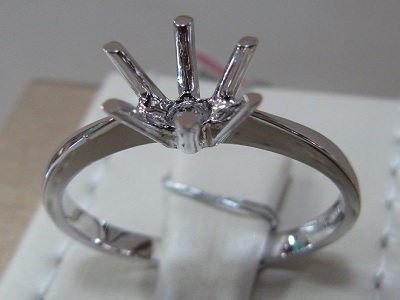
Semi-mount ring setting with an empty head.
The concept of a prong setting is pretty simple. Basically, prongs are made up of small strips of metal and they form a basket-like cradle to hold the center diamond. Once the diamond is seated inside and aligned correctly, the ends of the prongs are bent towards the diamond to hold it snugly in place.
Any excess prong ends will then be trimmed by the jeweler and finished by rounding up the edges of the prong. Depending on the design of the ring, prongs can be made taller to create a high mounting or be shortened to bring the diamond closer to the finger.
In a well-made ring, the prongs should not cover any part of the diamond’s table facet. The contact points between the prongs and crown of the diamond should also be flushed with no visible gaps.
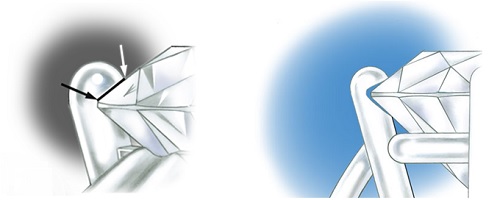
Correctly mounted prong vs incorrectly mounted prong with spacing.
Pros and Cons of Prong Settings in Diamond Jewelry
So, why are prong settings the most popular type of mountings used in engagement rings and diamond jewelry? Let’s take a look at their pros and cons to help you get some insights.
Advantages of Prong Settings
Prong settings are preferred by jewelers and consumers because they offer a good balance of security and cost without compromising design creativity.
– Minimal metal coverage and allows more light to hit the diamond.
– Relatively simple to make and cheaper than other settings.
– Straightforward maintenance and cleaning routines.
– Easily customizable to elevate or lower the diamond setting.
– Classy and timeless appearance.
– Complements a variety of diamond shapes and sizes.
Disadvantages of Prong Settings
– Less protection to exposed girdle areas of the diamond.
– Poorly made prongs can snag onto linen or clothing.
– Prongs may wear down or become loose overtime.
The Different Types of Prongs on Rings
Most prong settings feature either 4 or 6 prongs and rounded prongs are the most common type of appearance you will find on diamond rings. However, prongs can also be flat, pointed, squared, clawed, double clawed, V-shaped and even formed into decorative designs.
I’m going to show you some ring designs to help you visualize how the different types of prongs look like in a diamond engagement ring. Feel free to click on the images to interact with their 360° video listings…
Common Round Prong Setting
Round shaped prongs are the most common type of finishing you will find in prong settings. Rounded prongs cover a small area of the diamond’s surface and provide a strong clasp to secure the center stone.
Pointed/Claw Prong Tips
Pointed (or claw) prongs look sleek and are widely used in diamond engagement rings. Pointed prongs help emphasize the outline of the diamond and blends seamlessly into the diamond ring’s appearance.
Double Claw Diamond Ring Setting
Prong settings that make use of double clawed designs give an illusion that the claws are slimmer looking compared to using a single solid prong. Another variation of the double clawed prong is the double rounded prong tips where the prongs are finished with a rounded edge instead of a pointed appearance.
Flat Tab Prong Setting
Flat tab prongs have a lower height profile compared to other types of prongs and this makes them less susceptible to snagging.
V-prong Diamond Engagement Ring Setting
The V-prong setting is typically used in fancy shaped diamonds like pears, hearts and marquises. The idea behind having a v-prong is to protect the vulnerable tips of the diamond since they are susceptible to chipping.
Shared Prongs Ring Setting
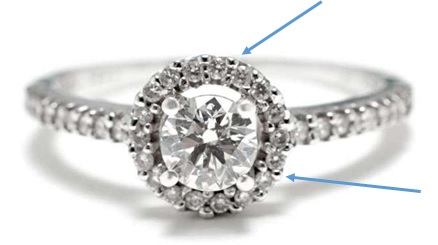
In the halo ring setting above, the “shared prongs” provide economical use of space on the ring. If you look at the blue arrows, you will notice that the shared prongs allow adjacent melee stones to be held in place with the same set of prongs.
This setting technique helps the jeweler save material (result in lower costs) and doesn’t overwhelm the appearance of the ring with unnecessary metal.
Decorative/Custom Prong Tips
Prongs can come in all kinds of designs and sizes. As seen above, there are ring designs that orientate the prong placements in a north-east-south-west manner and scalloped prong tips that are specifically made to complement the style of a ring.
If you are someone creative or want something completely unique, there are also customization services to help you create the type of prongs you have in mind.
What’s the Best Material for Prongs in an Engagement Ring?
I frequently get asked whether white gold or platinum would be a better material for prongs and which would be a better choice for security. The short answer is, both are recommended and you would be fine with either as long as you practice some common sense when wearing your jewelry.
Now, I know there are some ring designs that may utilize different metals for the band and head (e.g. platinum shank with 18k white gold prongs) because of lower costs or design specific features. Some jewelers may even claim that using a different metal for the prong mounting will provide additional security to the center stone.
Well, my recommendation is to keep things simple and use a uniform material for the entire ring because of practical reasons.
While both 18k white gold and platinum are good materials for diamond jewelry, there is a slight color difference between them. As the rhodium plating on the white gold wears out, this color difference will become more pronounced.
In terms of mechanical properties, 18k gold is stronger than platinum because of the alloyed metals in its composition. On the other hand, platinum is softer and denser which makes them more malleable and resistant to chipping when struck with force.
Technically speaking, platinum prongs are more durable than white gold prongs as they are less likely to chip when they are knocked. However, the differences in durability are marginal and aren’t going to matter as much as taking care of your jewelry when wearing it.
Tips to Choosing a Diamond Prong Setting Ring

Profile view of basket setting vs prong setting.
Prongs are universally found in different styles of engagement ring designs. Whether you are looking for a solitaire, three stone, pave, halo, basket, vintage or U-prong ring, here are some tips to help you make better purchase decisions.
In general, I would avoid overly thin and flat prongs as they are easier to break and wear away. I would also avoid ring designs that feature prong heads that are set very high as it will increase the risk of snagging and accidental knocks.
When it comes to aesthetics, I think it is important to choose rings with prong sizes that are proportionate to the carat size of the center stone. Otherwise, thick sized prongs can overpower the piece and make the overall appearance less attractive.
Very often, readers also ask me questions about the differences between 4 prong and 6 prong ring settings and which is better. Both are perfectly fine and it really depends on your personal preferences. I’ve written an indepth article where you can check out the differences and visual examples for both types of settings.
Let’s Wrap Things Up – Where to Buy High Quality Diamond Rings
This beautiful Vatche ring was the most recent purchase I made.
Regardless of the type or shape of a diamond ring’s prongs, their main function is to securely hold the center stone in place and to keep it safe when you are wearing the ring. Ultimately, the choice of ring style and design lies in your personal preferences.
When shopping for an engagement ring, some people tend to focus too much on the diamond and place little emphasis on the setting. However, I want to remind you that high quality workmanship is one of the key things that affect durability and the diamond ring’s overall appearance.
Now, I’ve personally purchased a number of diamond rings and performed indepth reviews where I scrutinized the smallest detail up close. If you are interested to find out more about the things to look out for, click here and here.
Related Articles
Leave A Comment

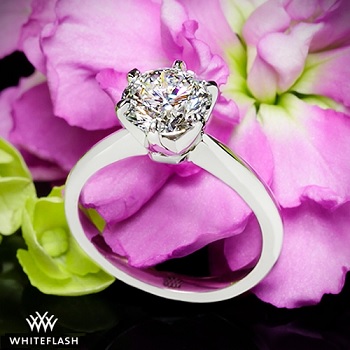
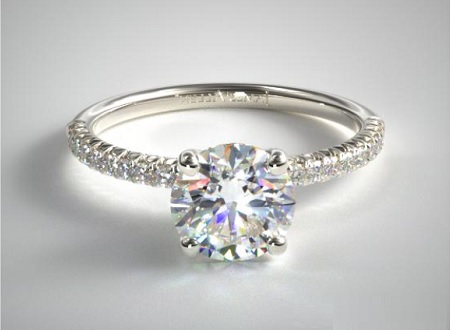
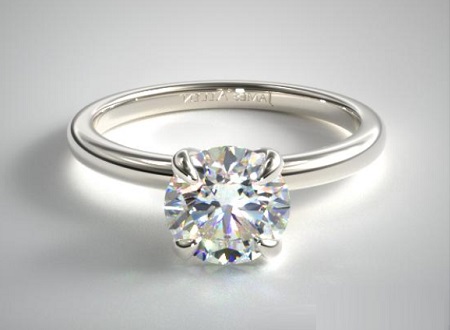
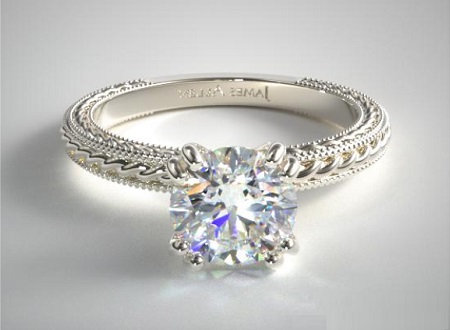
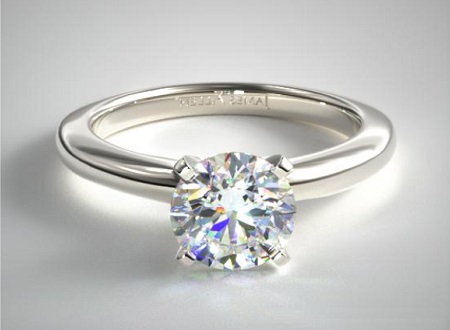
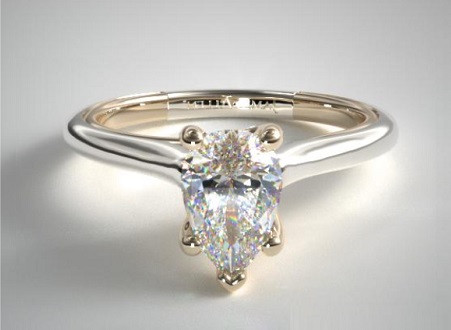


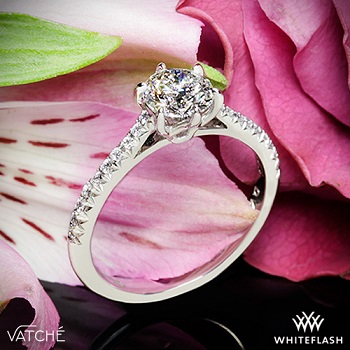

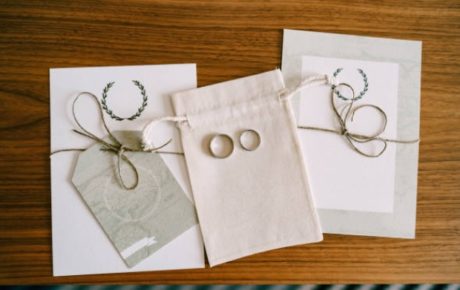
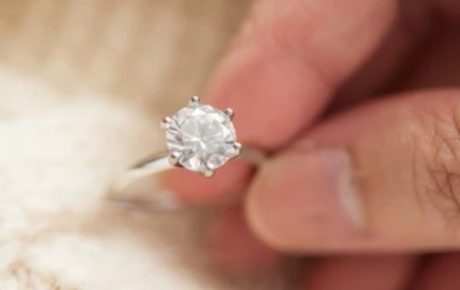
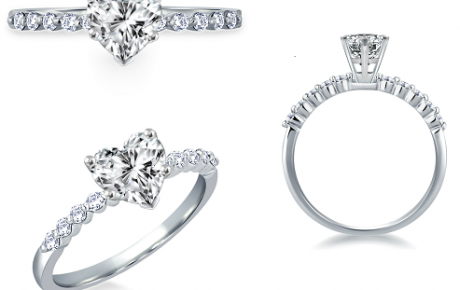









12 Comments
I’m a little confused. Is the Tiffany setting a prong setting or is it unique to Tiffany & Co? If it is a prong setting, why would they be able to win a lawsuit against Costco for selling 6 prong engagement ring settings?
I’m not privy to the legal details of the court case that Tiffany and Costco fought. So, I can’t offer much insights as to why and how the judge decided in the favor of Tiffany. Anyway, the Tiffany setting is a 6 prong solitaire ring design that is trademarked to the company. I know many jewelers use the term Tiffany prong setting loosely to market their own products because they offer a similar look design. It is to the point that many people are just associating solitaire prong engagement ring settings to Tiffany settings much like how people associate Colgate to toothpaste. But technically speaking, the iconic Tiffany design is a form of prong setting and one that is extremely popular in the consumer market.
I’m considering buying a small carat size engagement ring but can’t make up my mind between a bezel and a U shaped prong setting I found on White Flash. Which do you think would be better for a 0.5 carat diamond and are there much differences between a 4 prong and 6 prong setting for a small sized diamond?
Diamond prong settings also enable more light to enter the gemstone to enhance the engagement ring’s brilliance. The prongs can also be easily modified to higher (makes the diamond look larger) or lower positions (doesn’t catch onto things easily) depending on personal preferences. This guide about small engagement rings will also offer some insights.
Now, bezels cover up alot of the diamond and reduce the amount of light that can enter it. U prongs tend to have thicker prong thicknesses as well and that could also increase the amount of metal coverage. For a 0.5 ct diamond size, I do recommend a 4 prong design but really, when it comes to choosing a 4 prong or 6 prong diamond ring, I think it boils down to personal preferences.
What are the differences between basket setting vs prong setting vs bead set diamond rings? What do you think of premade rings?
The differences mainly lie in appearances. You can think of a basket setting as a simple 4 or 6 prong setting that has an additional strip of metal that wraps around the head (to mimic a basket). Arguably, basket settings will be more secure as the head can hold onto the diamond if a prong breaks.
Bead settings are used to describe ring designs where a groove is cut out directly from the ring’s shanks before the melee diamond is placed into the concave depression and held in place by prongs. The technique of bead setting is used on smaller sidestones instead of on large center stones.
Read this for my thoughts on premade rings: https://beyond4cs.com/jewelry-guide/preset-engagement-rings/
Is it possible and relatively easy to file/reshape round prongs into claw prongs or will the entire setting need to be redone?
The entire ring head should be redone for safety purposes.
I was wondering if you need a special head for cushion cut diamond? Or can you use the same head of a round diamond?
Thank you
The head will need to be changed and customed to fit the cushion cut diamond’s shape and dimensions. You CANNOT use the same head of a round diamond ring for a cushion cut.
What is the best way for prong orientation? N-S or offset for 6 prong? If N-S is used, does covering up the arrow head affect the diamond’s performance? Which orientation makes it look more like a snowflake?
There’s no best way for prong orientation. North and South placements are less common and if you want to make a statement, that can be a way to do it. Covering up the prong head does affect the scintillation of the diamond. The arrow tips (in a well cut diamond) tend to fire off more intense flashes of light and if you are looking to “max out” light return, keep the arrows exposed.